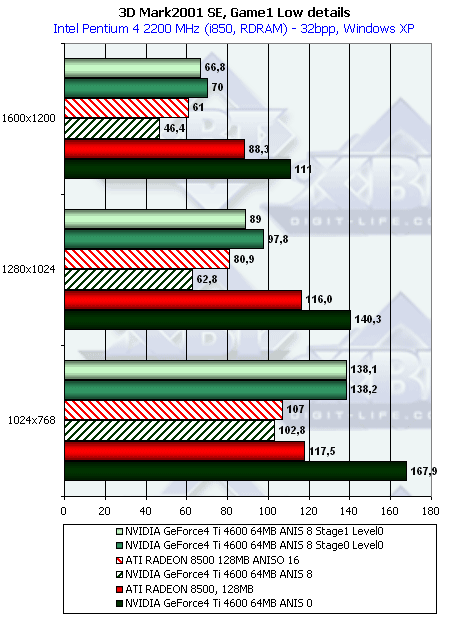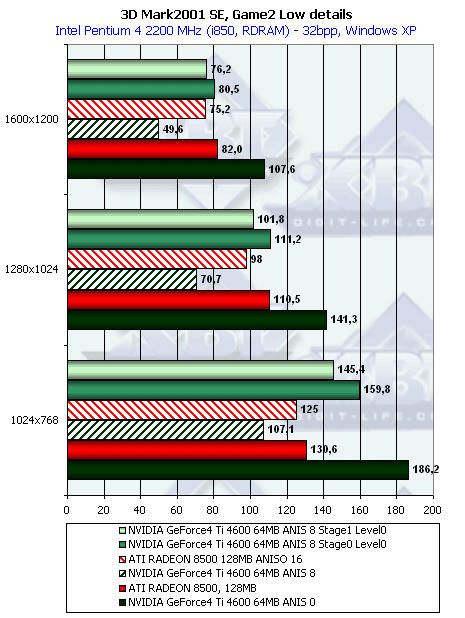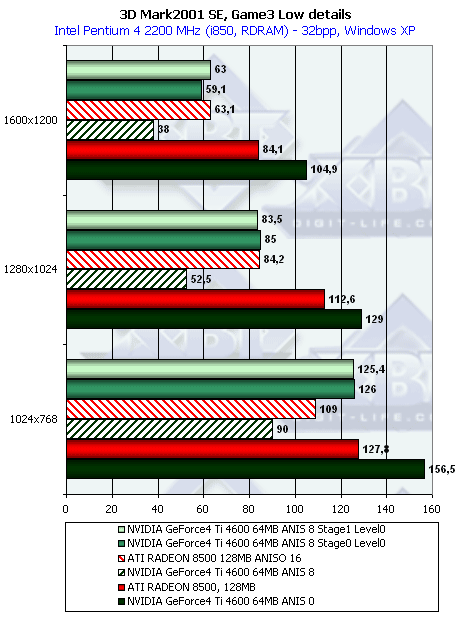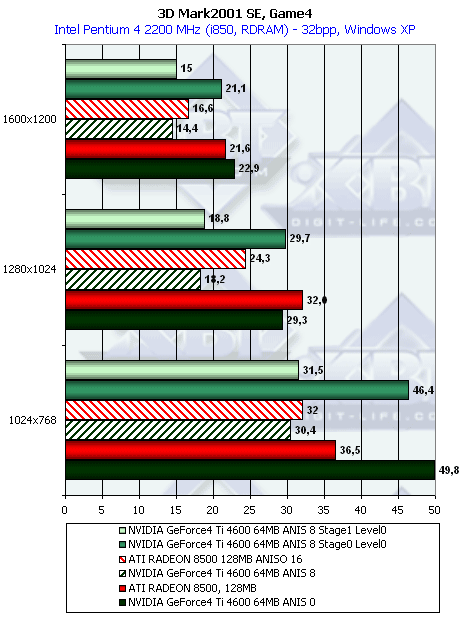 |
 |
 |
 |
| iXBT Labs - Computer Hardware in Detail |
|
|
|
|
 |
|
|
NVIDIA's Quick Anisotropy, Soltek GeForce4 Ti 4600 Video Card Review
|

CONTENTS
-
Peculiarities
of the Soltek
NVIDIA GeForce4 Ti 4600 video card
-
Test system configuration,
test tools, 2D quality
-
New capabilities
of anisotropic filtering in 30.* drivers from NVIDIA
-
Performance of
video cards of the GeForce4 Ti 4600 class
-
Conclusion
The summer's gone! And it took away with it 1.5 months since the announce
of the ATI RADEON 9700 which is a current leader in 3D graphics. Although
ATI promised to start deliveries a month later, these cards are becoming
available for users only now. I think the mass supplies will take place
only in the middle of September.
And what about the former leader GeForce4 Ti 4600? Although it was forced
off from the throne, its price doesn't fall down. Besides, the manufacturers
try to attract attention to the Ti 4200 by producing it on the Ti 4600's
PCB and with faster memory. For overclockers it means a moral death of
the Ti 4600 as one will hardly pay $310-330 for a card which can be made
out of the improved Ti 4200 available at the lower price.
But as the overclockers make just 5% of the overall number of users,
the popularity of the Ti 4600 can't be shaken (if it's possible to say
that $300 cards are popular). The release of the RADEON 9700 will favor
the price cuts, but at present despite relatively low release prices of
the manufacturers the market doesn't hurry to bring down the prices for
expensive components.
Apart from multiple GeForce4 Ti 4600 based cards from the grands available
at unreasonable prices the market offers solutions from less-known companies at
much smaller prices. But let's make a break and look through a list of reviews
of the GeForce4 Ti cards already published on our site.
Theoretical materials and reviews of video cards which concern
functional properties of the NVIDIA GeForce4 Ti GPU
- NVIDIA GeForce4
Ti review
- MSI GF4Ti4600
on NVIDIA GeForce4 Ti - concerns anisotropic filtering in the 3DMark2001 SE,
and new Advanced Pixel Shader Test from this packet.
- Leadtek
WinFast GeForce4 Ti 4600 on NVIDIA GeForce4 Ti 4600 - tests based on the Vulpine
GLMark with anisotropy enabled.
- Gainward
PowerPack GeForce4 Ultra/700XP and Ultra/750XP Golden Sample on NVIDIA GeForce4
Ti 4400/4600 - Codecult Code Creatures and Novalogic Comanche4 Benchmark.
- Chaintech
A-GF61 SE on NVIDIA GeForce4 Ti 4600 - dependence of the performance on a
CPU speed (AMD Athlon 750, 1000 MHz, Athlon XP 1250, 1666 MHz; in Serious Sam
II, Return to Castle Wolfenstein).
- Creative 3D
Blaster GeForce4 Ti 4400 on NVIDIA GeForce4 Ti 4400 - dependence of the performance
on a CPU speed (Intel Pentium III 1000, Pentium 4 2000, 2200 MHz; in Serious Sam
II, Return to Castle Wolfenstein).
- ASUS V8440
and V8460 on NVIDIA GeForce4 Ti 4400 and 4600 - dependence of the performance
on a CPU speed (Intel Pentium III 1000, Pentium 4 2000, 2200 MHz, AMD Athlon 750,
1000 MHz, Athlon XP 1250, 1666 MHz; in 3DMark2001 SE).
- ABIT Siluro
GF4 Ti on NVIDIA GeForce4 Ti 4400 - AA operation in the 3DMark2001 SE.
- Palit Daytona
GeForce4 Ti 4600 - operation of anisotropy on different platforms based on
the 3DMark2001 SE (Game1, Game2).
- Joytech
Apollo Bloody Monster II GeForce4 Ti 4600 - examination of anisotropy on different
platforms on the 3DMark2001 SE (Game3, Game4).
- S/U/M/A/ Platinum
GeForce4 Ti 4400 DVI and GeForce4 Ti 4600 SE - examination of anti-aliasing
on different platforms in 3DMark2001 SE (Game1, Game2).
- Triplex
Millennium Silver GeForce Ti 4600 - examination of anti-aliasing on different
platforms in 3DMark2001 SE (Game3, Game4).
- Leadtek
WinFast A250LE 64 MBytes and Gainward Powerpack Ultra/650XP 128 MBytes on NVIDIA
GeForce4 Ti 4200
- S/U/M/A/
Platinum GeForce4 Ti 4200 64 MBytes, GeForce4 Ti 4200 SE 64 MBytes, GeForce4 Ti
4200 SE 128 MBytes - examination of anisotropy in Return to Castle Wolfenstein,
Serious Sam: The Second Encounter.
- S/U/M/A/
Platinum GeForce4 Ti 4200 64 MBytes, 4200SE 64 MBytes and 4200SE 128 MBytes
- examination of anisotropy in 3DMark2001 SE, RtCW, Serious Sam: TSE.
- Sparkle
GeForce4 Ti 4400 and GeForce4 Ti 4600 cards.
- ABIT Siluro GF4Ti4200, Prolink
PixelView GeForce4 Ti 4200, Palit Daytona GeForce4 Ti 4200 128MB and Gainward
Powerpack Ultra/650XP 64MB on NVIDIA GeForce4 Ti 4200
- Albatron
GeForce4 Ti 4200 128MB, Sparkle GeForce4 Ti 4200 128MB and Gainward Powerpack
Ultra/650XP GS 64MB on NVIDIA GeForce4 Ti 4200 - analyses of the Nvidia's
quick anisotropy under the 30.* drivers in 3DMark2001SE.
It should be noted that some inexpensive cards, for example from Sparkle, has
not worse quality as compared with the market's giants, and they are in quite
good demand. Well, Soltek joined this group. Let's look at it closer.
Card
| Soltek GeForce4 Ti 4600 |

|

|
| Soltek GeForce4 Ti 4600 |
| The card has AGP x2/x4 interface, 128 MB DDR SDRAM located in
8 chips on both PCB sides.
The card comes with Samsung memory of 2.8ns access time which corresponds
to 357 (714) MHz; the memory works at 325 (650) MHz. The GPU runs at 300
MHz which is typical of the Ti 4600. |

|
| Comparison with the reference design, front view |
| Soltek GeForce4 Ti 4600 |
Reference card NVIDIA GeForce4 Ti 4600 |

|

|
| Comparison with the reference design, back view |
| Soltek GeForce4 Ti 4600 |
Reference card NVIDIA GeForce4 Ti 4600 |

|

|

This model is a pure copy of the reference card. Its quality is visually
very high.
As you know, all cards that follow the reference design differ only in a cooling
device, VIVO and an accessory pack.
|
| Soltek GeForce4 Ti 4600 |
| Once we saw such a two-fan system on a card from Leadtek,
but that design was more massive. Soltek made the cooler smaller; and now
it doesn't cool down memory as it doesn't have a heatsink on its back.
When we took off the heatsink we saw that it worked only for the GPU and
just two chips (probably the thermo stickers play also a good fixing role
:-) ). |

|

|
The cooler hides the GeForce4 Ti 4600 GPU:

The card comes with the Philips 7108 chip, i.e. the VIVO (Video-In Video-Out)
is supported. Soon we will study functional properties of the Video In
of the Philips 7108 chip which has become very popular as all card starting
from the NVIDIA GeForce2 MX use it.
Now let's pop into the box:
| Soltek GeForce4 Ti 4600 |
| Here we can find a user manual, a CD with drivers and utilities,
CyberLink Power Director (for VIVO), PowerDVD XP, Serious Sam game, DVI-to-VGA
adapter, an adapter/splitter for VIVO. |

|
The video card ships in retail packages.
| Soltek GeForce4 Ti 4600 |
| This luxurious package will certainly attract attention.
Its the first time when a relief image is used on a bright colorful box.
But inside, the box doesn't look so elaborated, the stuff can easily fall
out of it onto your feet. |

|

|

|
That's all about peculiarities of the card.
Overclocking
| Soltek GeForce4 Ti 4600 |
300/650 -> 326/715 MHz, good overclocking potential (but it's
not a new record). |

Note:
-
in course of overclocking you must provide additional cooling, in particular,
for the card (first of all, for its memory):

-
overclocking depends on a definite sample, and you shouldn't generalize
the results of one card to all video cards of this mark or series. The
overclocking results are not the obligatory characteristics of a video
card.
Test system and drivers
Testbeds:
-
Pentium 4 2200 MHz based computer:
-
Intel Pentium 4 2200 (L2=512K);
-
ASUS P4T-E (i850);
-
512 MB RDRAM PC800;
-
Quantum FB AS 20GB;
-
Windows XP.
-
Athlon XP 1666 MHz (2000+) based computer:
-
AMD Athlon XP 2000+
-
EPoX 8KHA+ (VIA KT266A);
-
512 MB DDR SDRAM PC2100;
-
Fujitsu 20 GB;
-
Windows XP.
The test system was coupled with ViewSonic P810 (21") and
ViewSonic P817 (21") monitors.
In the tests we used NVIDIA's drivers of v30.82. VSync was off, S3TC
was off. When the review was finished the comapny released a new version
of the drivers 40.41. Its operation will be examined in one of the following
reviews.
Test results
Before we start examining 2D quality I should say that there is no a complete
technique of objective estimation of this parameter because:
-
Almost all modern 3D accelerators can have 2D quality much dependent on
a certain sample, and it's impossible to trace all cards;
-
2D quality depends not only on a video card, but also on a monitor and
a cable;
-
Besides, certain monitors do not get along with certain video cards.
As for the tested samples, together with the ViewSonic P817 monitor
and BNC Bargo cable the cards showed excellent quality at the
following resolutions and frequencies:
| Soltek GeForce4 Ti 4600 |
1600x1200x85Hz, 1280x1024x100Hz, 1024x768x120Hz |

For the performance estimation we used:
- Return to Castle Wolfenstein (MultiPlayer) (id Software/Activision) - OpenGL,
multitexturing, Checkpoint-demo,
test settings - maximum, S3TC OFF, the configurations can be downloaded
from here
Test order: enable the console with the '~' button and type:
timedemo 1 (press Enter)
demo checkpoint (press Enter)
- 3DMark2001 SE Pro (MadOnion/Remedy), Game2 "Dragothic" - DirectX 8.0,
Hardware TCL, multitexturing, LOW Details, DXTC OFF, double buffering,
24-bit Z-buffer
Test order:
through the 3DMark2001 menu of settings
using the Batch mode
- Serious Sam: The Second Encounter v.1.05 (Croteam/GodGames) - OpenGL, multitexturing,
Grand Cathedral demo, test settings: quality, S3TC OFF
Test order: enable the console with the '~' button and type:
dem_bProfile=1 (press Enter)
start up Grand Cathedral demo from the menu
- 3DMark2001 Pro (MadOnion/Remedy) - DirectX 8.0, Hardware
TCL, Game1, Game2, Game3, Game4, Low, High detail levels
- Comanche4 Benchmark Demo (NovaLogic) - Direct3D, Shaders, Hardware T&L,
Dot3, cube texturing, highest quality
Test order: start up the game the following way:
c4demo.exe /advbench fps.txt 1024 32 noaudio nct dx7 (press Enter)
- Unreal Tournament 2003 Demo v.927 (Digital Extreme/Epic Games) - Direct3D,
Vertex Shaders, Hardware T&L, Dot3, cube texturing, default quality
Test order: run benchmark.bat from folder System of the game changing only
the resolution.
- RightMark Video Analyzer v.0.4 (Philip
Gerasimov) - DirectX 8.1, Dot3, cube texturing, shadow buffers, vertex and
pixel shaders (1.1, 1.4).
test settings: pixel shaders 1.1, shadow buffers OFF.
New capabilities of anisotropic filtering in 30.* drivers from NVIDIA
As we mentioned in the GeForce4
Ti 4200 review (Part 3) this function in the GeForce4 Ti family takes a great
deal of resources - the performance falls down by 50-55% when the Level 8 is enabled.
Although NVIDIA's anisotropy is more correct and all surfaces are processed irrespective
of an angle of inclination, still, a too great speed fall irritates a lot. For
details of anisotropy of ATI and NVIDIA see our 3Digest.
We've also found out that the best way to manage the anisotropic filtering
is with the help of RivaTuner developed by Aleksei Nikolaichuk AKA Unwinder.
The last version of this program can enable anisotropy and adjust its
speed and quality. But it works only starting from the v30.* drivers.



In the Direct3D section it's possible to choose an anisotropy degree and
optimize it. The drivers allow setting the highest filtering degree for
each texture stage! It's possible to combine the modes.
Last time we estimated in the 3DMark2001 (Game1, Game2, Game4) how reduction
of an anisotropy level impacts quality at the texture stages 0 and 1. We
set the Level 8, and reduced it to 2 or 4 for each texture stage.
And now let's disable the anisotropy at all at the same texture stages,
separately for each stage.
| Stage0 |
Stage1 |
| Game 1 |
| ANISO 8 |

|
| ANISO 8 Stage0 Level0 |
ANISO 8 Stage1 Level0 |

|

|
| Game 2 |
| ANISO 8 |

|
| ANISO 8 Stage0 Level0 |
ANISO 8 Stage1 Level0 |

|

|

Let me show you the quality difference in animated GIF files:
| Game 1 |
Game 2 |

|

|

What results this examination produces?
-
For the Game1 it's better to disable the anisotropy at the texture stage
0, almost no quality difference. Below we will find out about the performance.
-
For the Game2 disabling of the anisotropy at the texture stage 0 brings
bad artifacts. It makes sense to disable it at the stage 1.
Now we turn to the performance scores, with anisotropy activated in the
above mentioned modes.
Game 1 Low details


We said that it's better to optimize the filtering at the texture stage
0 to achieve better quality. The performance gap is now twice narrower!
Game 2 Low details


And here, although the speed gain is greater when the anisotropy is disabled
at the texture stage 0, the quality obtained shows that such optimization
isn't good. At the first texture stage the effect is smaller, though the
percentage of the performance drop falls down twice.
Game 3 Low details


In this case both optimization modes are equal as far as the performance
is concerned.
Game 4


Here the effect of the anisotropy is not so obvious because of a great
deal of tiny objects. That is why it's better to disable the filtering
at the texture stage 0 to provide a higher speed; the quality doesn't depend
much on the optimization.
Overall performance
The overclocked cards are marked with red color, sign o/c (overclocked)
is followed by the frequencies reached.
-
1. Return to Castle Wolfenstein - maximum quality settings
-
2. Unreal Tournament 2003 DEMO b.927 - standard settings
-
3. Comanche4 DEMO
-
4. Comanche4 DEMO (min-max)
-
5. 3DMark2001, Game2 Low Details (Dragothic)
-
Windows
XP
-
Tests
on Athlon XP 2000+ (1666 MHz),resolution 1024x768
-
Tests
on Athlon XP 2000+ (1666 MHz),resolution 1280x1024
-
Tests
on Athlon XP 2000+ (1666 MHz),resolution 1600x1200
-
Tests
on Athlon XP 2000+ (1666 MHz), 800x600, Anti-aliasing
-
Tests
on Athlon XP 2000+ (1666 MHz), 1024x768, Anti-aliasing
-
Tests
on Athlon XP 2000+ (1666 MHz), 1280x1024, Anti-aliasing
-
Tests
on Pentium 4 2200 MHz,resolution 1024x768
-
Tests
on Pentium 4 2200 MHz,resolution 1280x1024
-
Tests
on Pentium 4 2200 MHz,resolution 1600x1200
-
Tests
on Pentium III 1000 MHz,resolution 1024x768
-
Tests
on Pentium III 1000 MHz,resolution 1280x1024
-
Tests
on Pentium III 1000 MHz,resolution 1600x1200
-
6. Serious Sam: The Second Encounter
-
Windows
XP
-
Tests
on Athlon XP 2000+ (1666 MHz),resolution 1024x768
-
Tests
on Athlon XP 2000+ (1666 MHz),resolution 1280x1024
-
Tests
on Athlon XP 2000+ (1666 MHz),resolution 1600x1200
-
Tests
on Athlon XP 2000+ (1666 MHz), 800x600, Anti-aliasing
-
Tests
on Athlon XP 2000+ (1666 MHz), 1024x768, Anti-aliasing
-
Tests
on Athlon XP 2000+ (1666 MHz), 1280x1024, Anti-aliasing
-
Tests
on Pentium 4 2200 MHz,resolution 1024x768
-
Tests
on Pentium 4 2200 MHz,resolution 1280x1024
-
Tests
on Pentium 4 2200 MHz,resolution 1600x1200
-
Tests
on Pentium III 1000 MHz,resolution 1024x768
-
Tests
on Pentium III 1000 MHz,resolution 1280x1024
-
Tests
on Pentium III 1000 MHz,resolution 1600x1200
-
7. 3DMark2001
-
7.1. 3DMark2001 standard tests
-
Windows
ME
-
Tests
on Athlon XP 2000+, 1024x768, 3D Marks
-
Tests
on Athlon XP 2000+, 1024x768, Game1 Low
-
Tests
on Athlon XP 2000+, 1024x768, Game1 High
-
Tests
on Athlon XP 2000+, 1024x768, Game2 Low
-
Tests
on Athlon XP 2000+, 1024x768, Game2 High
-
Tests
on Athlon XP 2000+, 1024x768, Game3 Low
-
Tests
on Athlon XP 2000+, 1024x768, Game3 High
-
Tests
on Athlon XP 2000+, 1024x768, Game4
-
Tests
on Athlon XP 2000+, 1280x1024, 3D Marks
-
Tests
on Athlon XP 2000+, 1280x1024, Game1 Low
-
Tests
on Athlon XP 2000+, 1280x1024, Game1 High
-
Tests
on Athlon XP 2000+, 1280x1024, Game2 Low
-
Tests
on Athlon XP 2000+, 1280x1024, Game2 High
-
Tests
on Athlon XP 2000+, 1280x1024, Game3 Low
-
Tests
on Athlon XP 2000+, 1280x1024, Game3 High
-
Tests
on Athlon XP 2000+, 1280x1024, Game4
-
Tests
on Athlon XP 2000+, 1600x1200, 3D Marks
-
Tests
on Athlon XP 2000+, 1600x1200, Game1 Low
-
Tests
on Athlon XP 2000+, 1600x1200, Game1 High
-
Tests
on Athlon XP 2000+, 1600x1200, Game2 Low
-
Tests
on Athlon XP 2000+, 1600x1200, Game2 High
-
Tests
on Athlon XP 2000+, 1600x1200, Game3 Low
-
Tests
on Athlon XP 2000+, 1600x1200, Game3 High
-
Tests
on Athlon XP 2000+, 1600x1200, Game4
-
Windows
XP
-
Tests
on Pentium 4 2200 MHz, 1024x768, 3D Marks
-
Tests
on Pentium 4 2200 MHz, 1024x768, Game1 Low
-
Tests
on Pentium 4 2200 MHz, 1024x768, Game1 High
-
Tests
on Pentium 4 2200 MHz, 1024x768, Game2 Low
-
Tests
on Pentium 4 2200 MHz, 1024x768, Game2 High
-
Tests
on Pentium 4 2200 MHz, 1024x768, Game3 Low
-
Tests
on Pentium 4 2200 MHz, 1024x768, Game3 High
-
Tests
on Pentium 4 2200 MHz, 1024x768, Game4
-
Tests
on Pentium 4 2200 MHz, 1280x1024, 3D Marks
-
Tests
on Pentium 4 2200 MHz, 1280x1024, Game1 Low
-
Tests
on Pentium 4 2200 MHz, 1280x1024, Game1 High
-
Tests
on Pentium 4 2200 MHz, 1280x1024, Game2 Low
-
Tests
on Pentium 4 2200 MHz, 1280x1024, Game2 High
-
Tests
on Pentium 4 2200 MHz, 1280x1024, Game3 Low
-
Tests
on Pentium 4 2200 MHz, 1280x1024, Game3 High
-
Tests
on Pentium 4 2200 MHz, 1280x1024, Game4
-
Tests
on Pentium 4 2200 MHz, 1600x1200, 3D Marks
-
Tests
on Pentium 4 2200 MHz, 1600x1200, Game1 Low
-
Tests
on Pentium 4 2200 MHz, 1600x1200, Game1 High
-
Tests
on Pentium 4 2200 MHz, 1600x1200, Game2 Low
-
Tests
on Pentium 4 2200 MHz, 1600x1200, Game2 High
-
Tests
on Pentium 4 2200 MHz, 1600x1200, Game3 Low
-
Tests
on Pentium 4 2200 MHz, 1600x1200, Game3 High
-
Tests
on Pentium 4 2200 MHz, 1600x1200, Game4
-
7.2. Comparison of the test results with the Software T&L and with
the Hardware T&L
-
Windows
ME
-
Tests
on Athlon XP 2000+, 1024x768, Game1 Low
-
Tests
on Athlon XP 2000+, 1024x768, Game1 High
-
Tests
on Athlon XP 2000+, 1024x768, Game2 Low
-
Tests
on Athlon XP 2000+, 1024x768, Game2 High
-
Tests
on Athlon XP 2000+, 1024x768, Game3 Low
-
Tests
on Athlon XP 2000+, 1024x768, Game3 High
-
Tests
on Athlon XP 2000+, 1024x768, Game4
-
Tests
on Athlon XP 2000+, 1280x1024, Game1 Low
-
Tests
on Athlon XP 2000+, 1280x1024, Game1 High
-
Tests
on Athlon XP 2000+, 1280x1024, Game2 Low
-
Tests
on Athlon XP 2000+, 1280x1024, Game2 High
-
Tests
on Athlon XP 2000+, 1280x1024, Game3 Low
-
Tests
on Athlon XP 2000+, 1280x1024, Game3 High
-
Tests
on Athlon XP 2000+, 1280x1024, Game4
-
Tests
on Athlon XP 2000+, 1600x1200, Game1 Low
-
Tests
on Athlon XP 2000+, 1600x1200, Game1 High
-
Tests
on Athlon XP 2000+, 1600x1200, Game2 Low
-
Tests
on Athlon XP 2000+, 1600x1200, Game2 High
-
Tests
on Athlon XP 2000+, 1600x1200, Game3 Low
-
Tests
on Athlon XP 2000+, 1600x1200, Game3 High
-
Tests
on Athlon XP 2000+, 1600x1200, Game4
-
Windows
XP
-
Tests
on Pentium 4 2200 MHz, 1024x768, Game1 Low
-
Tests
on Pentium 4 2200 MHz, 1024x768, Game1 High
-
Tests
on Pentium 4 2200 MHz, 1024x768, Game2 Low
-
Tests
on Pentium 4 2200 MHz, 1024x768, Game2 High
-
Tests
on Pentium 4 2200 MHz, 1024x768, Game3 Low
-
Tests
on Pentium 4 2200 MHz, 1024x768, Game3 High
-
Tests
on Pentium 4 2200 MHz, 1024x768, Game4
-
Tests
on Pentium 4 2200 MHz, 1280x1024, Game1 Low
-
Tests
on Pentium 4 2200 MHz, 1280x1024, Game1 High
-
Tests
on Pentium 4 2200 MHz, 1280x1024, Game2 Low
-
Tests
on Pentium 4 2200 MHz, 1280x1024, Game2 High
-
Tests
on Pentium 4 2200 MHz, 1280x1024, Game3 Low
-
Tests
on Pentium 4 2200 MHz, 1280x1024, Game3 High
-
Tests
on Pentium 4 2200 MHz, 1280x1024, Game4
-
Tests
on Pentium 4 2200 MHz, 1600x1200, Game1 Low
-
Tests
on Pentium 4 2200 MHz, 1600x1200, Game1 High
-
Tests
on Pentium 4 2200 MHz, 1600x1200, Game2 Low
-
Tests
on Pentium 4 2200 MHz, 1600x1200, Game2 High
-
Tests
on Pentium 4 2200 MHz, 1600x1200, Game3 Low
-
Tests
on Pentium 4 2200 MHz, 1600x1200, Game3 High
-
Tests
on Pentium 4 2200 MHz, 1600x1200, Game4
-
8. iXBT RightMark Video Analyzer
Conclusion
I must say that the new optimization way of the anisotropic filtering by
reducing quality of processing of farther objects hasn't failed. The new
method which provides a performance growth of the GeForce4 Ti with the
anisotropy activated has a complicated effect. The quality doesn't suffer
much, which is very important as a user gets a flexible tool for adjusting
the balance between quality and speed (when the anisotropy enabled). Next
time we will find out what the new driver 40.41 allows for.
About the tested card:
-
Soltek's video card has a perfect combination of the price and speed (it
also supports VIVO).
-
The reference design is supported, which is one more benefit.
-
The light version of the cooler, which cools only the chip, is an advantage
as well. We showed that such heavy systems covering both a chip and memory
don't bring anything good as the heat is delivered to the memory chips
which worsens their temperature mode.
The complete comparison characteristics of video cards of this and other classes
can be found in our 3Digest.
Highs:
-
Excellent performance in 3D games;
-
Superb quality of the reference-based card;
-
VIVO;
-
All necessary adapters included;
-
Relatively low price.
Lows:
Write a comment below. No registration needed!
|



![]()

![]()









![]()


![]()

















